|
- Catalog (in stock)
- Back-Catalog
- Mail Order
- Online Order
- Sounds
- Instruments
- Projects
- History Face
- ten years 87-97
- Review Face
- our friends
- Albis Face
- Albis - Photos
- Albis Work
- Links
- Home
- Contact
- Profil YouTube
- Overton Network
P & C December 1998
- Face Music / Albi
- last update 03-2016
|

Gankhuyag Natsag, director |
Ensemble Khan Bogd
The ensemble was founded in 1997. All its members have studied at the academy of music in Ulaanbaatar.
The Mongolians conferred the title Khan (Khan = King) to their highest-ranking ruler (tribal chief) of the tribes. Undur Gegeen Zanabazar was the first Bogd (1635-1723), this high-ranking Buddhist monk ruled from Urga, the historic capital of Mongolia. He was a celebrated monk and statesman, and he was also Mongolia's greatest artist. Since Zanabazar, this highest-ranking representative of the Buddhists in the 17th century, the title Khan Bogd (King Bogd) has been established. Khans were simultaneously highest-ranking Buddhist as well as profane leaders. The last Mongolian Khan Bogd died in 1924. He was the last religious and profane ruler of the Mongols who resided in the Khan Bogd Palace. The place of residence was called Ulaanbaatar, i.e. 'Red Warriors' or 'Red Heroes'.
In the Mongolian language this designation is also used for important or holy mountains or even whole mountain ranges, such as the Tavan Bogd Mountain Range in the Northern Mongolian part “Khuvsgul“ aimark, the Aj Bogd-Mountain in the Western Mongolian area of the Gobi-Altai province, or the Bogd Khan Mountain Range near Ulaanbaatar, the oldest Mongolian nature reserve (today it is a national park).
|
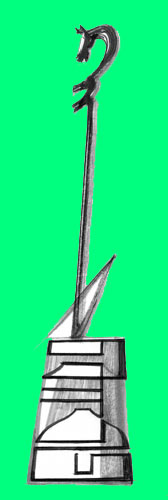 |
The Mongolian songs have a rich repertory. Music spread from home to home on the occasion of festivities and by way of teaching. The family or the clan meeting constituted a good chance to gather and sing together, the chance to learn from others, and to take home a new melody. In this way, the ancient patterns performed in various corners of Mongolia have been preserved by local masters for the whole nation. Some specific types are: labor songs (work songs); buuvei songs (lullaby); hunter's calls [to attract animals by imitating their call); various herder's calls, [to manage the herds by means of signalling (each animal has its own signal)]; uukhai or gulyingoon songs which are linked to seasonal events (arrival of spring, mare milk flows, horse race training, etc.); many other songs announcing birthdays, weddings, national holidays, winning a horse race or a wrestling competition, celebration of the elders, wool cutting, cashmere combing, arrival of harvest and many more songs for singing and dancing together.
The nomad shepherds in Mongolia, like other nomads from Central Asia, used to play string and wind instruments. The national music of Mongolia has had a rich background and a great tradition that goes back many centuries. Ensembles (orchesters) have performed at court or in the monasteries for lamaistic celebrations or in ritual ceremonies. Ensembles also play for daily rites in the ger (round tents). The morin khuur (horse-head violin or 'fiddle') (morin = horse; khuur = sound, rhyme, melody) is the most important traditional instrument for dance and to accompany songs. It is the national instrument. |
 
- Ensemble
|
- Khöömij (throat singing) and Magtaal (praise songs)
|
|
|
|
- Ensemble; traditional songs and female voice
|
|
- Battulga Nomin-Erdene - female voice
|
|
- Buyankhishig Togtokhjargal - morin khuur
|
|
- Gankhuyag Uyanga - khuuchir, female voice
|
|
- Gankhuyag Solongo - yatga, female voice
|
|
|
|
- Trad. Dance, Shaman dance, Mask dance (Tsam) and Contortionist
|
- Instruments
The traditional Mongolian Folk music is influenced by the large variety of tribes, having been united for the first time in the 13th century under the rule of Genghis Khan with Turkish tribes in order to establish the Mongolian people. The nomad shepherds in Mongolia, like other nomads in Central Asia, use to play string and wind instruments.
Percussion instruments, though, were only played in connection with Shamanism and Buddhism, the origins of which can be found in Tibetan Lamaism, as well as with the "Tsam dance", which was performed in Mongolia for the first time in the 8th century.
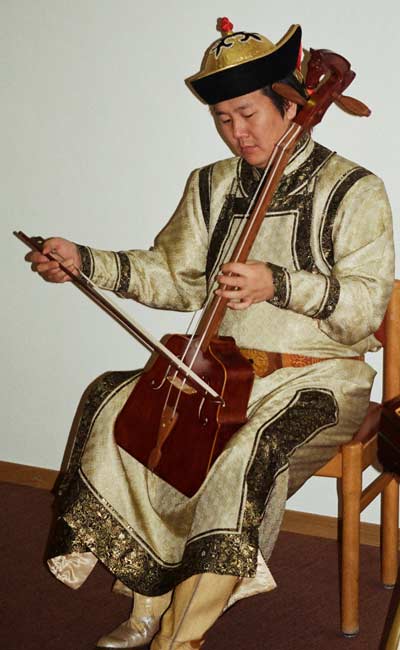
Buyankhishig
Togtokhjargal
|
- Morin khuur (string instrument - horse-head-violin)
The morin khuur is a typical Mongolian two-stringed instrument. The body and the neck are carved from wood. The end of the neck has the form of a horse-head and the sound is similar to that of a violin or a cello. The strings are made of dried deer or mountain sheep sinews. It is played with a bow made of willow, stringed with horsetail hair and coated with larch or cedar wood resin.
|
- Khun tovshuur - Tovshuur (string instrument)
The khun tovshuur is a two-stringed instrument similar to the lutes of Tuva, Altai or Kazakhstan. The body and the neck are carved from cedar wood and the body is often covered with the leather of wild animals, camels or goats. The head of the neck is formed like a swan. The Mongol legends say that they originate from a swan. The strings are wound from horsetails hair and tuned in the interval of a fourth.
The West Mongols used this traditional instrument to accompany the "tuuli" (heroic-epic myths) and "magtaal" (praise songs).
|
 Battulga Nomin-Erdene
Battulga Nomin-Erdene
|
|
- Yatga (string instrument)
The yatga is a half-tube zither with a movable bridge. It is constructed as a box with a convex surface and an end bent towards the ground. The strings are plucked and the sound is very smooth. The instrument was considered to be sacrosanct and playing it was a rite, bound to taboos. The instrument was mainly used at court and in monasteries, since strings symbolised the twelve levels of the palace hierarchy.
|
  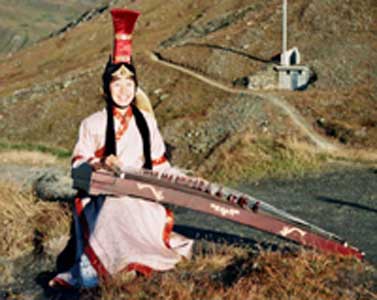
Gankhuyag Solongo
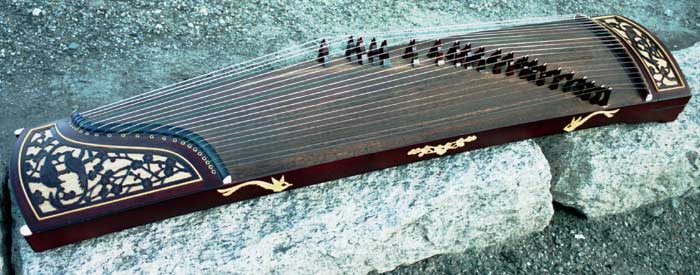
|
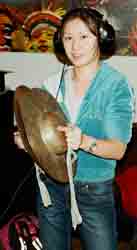
|
- Cymbals = small sound plates (Mongolian: Tsan)
They look like small brass plates, in the middle of which there are put knob-like handgrips.
|
|
- Shigshuur - shaman rattle (percussion instrument)
The Mongolian Shamans also use a type of rattle called the Shigshuur. It is made from a cow horn, with the pointed end being carved into the shape of a raven's head. The Shigshuur is used to direct and send energy in a specific direction, the rattle being shaken like a raven pecking.
|
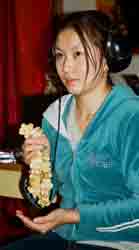
Gankhuyag Solongo
|
- Rattle
|
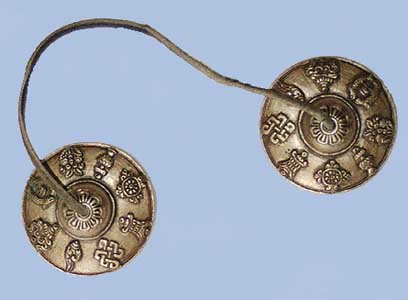 
|
- Denshig – small bells (percussion instrument)
They are only used in the Mongolian region. These are two plainished brass plates, the grips (knobs) of which are connected by means of a small band. On the occasion of services, a lama bangs the two little plates together, thereby producing a sound similar to the touch of a small bell but significantly softer and more melodic.
|

Gankhuyag Solongo
|
- Damar (percussion instrument)
Small drums used in monasteries, a wooden casing with resemblance to a coil. On both outer surfaces it is coated with leather. In the middle of the coil there is a band made from silk with emobroidery and two buttons attached to a string. By moving back and forth, these two buttons are hit on the stretched leather of this small drum.
|

|
- Tuur - frame drum - shaman drum (percussion instrument)
Is a single-headed shaman drum. Its frame is usually oval but sometimes round. The membrane is ornamented with drawings on one ore both sides.
|
|
- Shaman bells (percussion instrument)
The small bells are made of brass, or iron. They are fixed up on the cloth. These bells are mostly signal bells which shamans used in a dance to awaken the gods.
|
- Vocal music
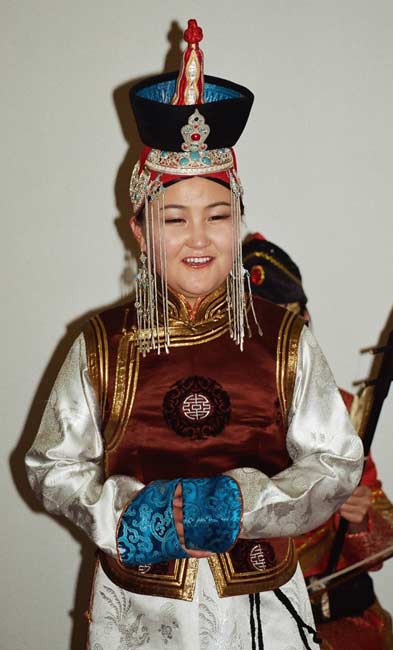
|
- Urtyin duu (long song) - melismatic and richly ornamented, with a slow tempo, long melodic lines, wide intervals and no fixed rhythm.
People usually practise these long songs while being alone in the open steppe and riding along slowly. The repertory is an expression of the liberty and the vastness of the Mongolian steppe and is used to accompany the rites of the seasonal cycles and the ceremonies of everyday life. Long songs are an integral part of the celebrations held in the round tents and they must be sung following the strict rules of performance.
- Bogin duu (short song) - strophic, syllabic, rhythmically tied, sung without ornaments.
Short songs are never sung at celebrations, since they are spontaneously improvised and rather satirical. They are often sung in the form of a dialogue and speak of certain friends and incidents, or they are lyrical tales about love, about everyday life and about animals, especially horses.
|
|
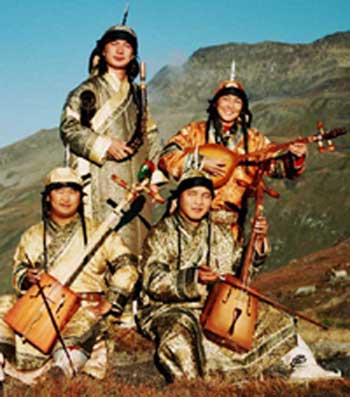
Orkhonbaatar Chinbat, Gereltsogt Jamba, Dorjnyam Shinetsog-Gyeni and Ganburged Bukhchuluun
|
- Magtaal (praising songs)
Magtaal are sung in honour of the gods of Lamaism and the spirits of nature, heralds or particular animals. Epic texts also contain praise songs for the mountains, the rivers, and nature in general. This is an ancient tradition still practised up to date by the tribes in the region of Mongol-Altai in Western Mongolia.
- Khöömij (overtone singing)
The performance of overtone singing takes usually place during social events such as eating or drinking parties.
The Mongols call their overtone singing höömij (= throat, pharynx). The singer creates a constant pitched fundamental considered as a drone, and at the same time modulates the selected overtones to create a formantic melody from harmonics.
|

Dorjnyam Shinetsog-Gyeni
and Ganburged Bukhchuluun
|
- Folk dance
  |
When the Zakhchin and the tribes of Western Mongolia dance their folk dances ("bij" - "bielgee"), they mainly move the upper part of the body. With their movements they express their identity and gender as well as their tribal and ethnic affiliation. Besides the gender-specific movements, there are others that imitate typical activities of their everyday life, such as the nomadic herdsmen's life, the daily work in the fields or the historical events of their tribe. This kind of dance is mainly performed during celebrations inside the ger (round tents), during festivals of the local nobility or during ceremonies in the monasteries.
Every tribe has its particular forms of expression.
|
- Religious dance - "Tsam"
In the past, the mystery dances were of considerable significance in Mongolia. They were always accompanied by music. For these ritual dances the monks wore dance masks made of papier maché. The tsam symbolised the battle of the gods against the enemies. In animism, the oldest form of religious belief (e.g. the Bon-religion), one believes that the whole nature is animated. Human beings and animals are surrounded by good and evil spirits.
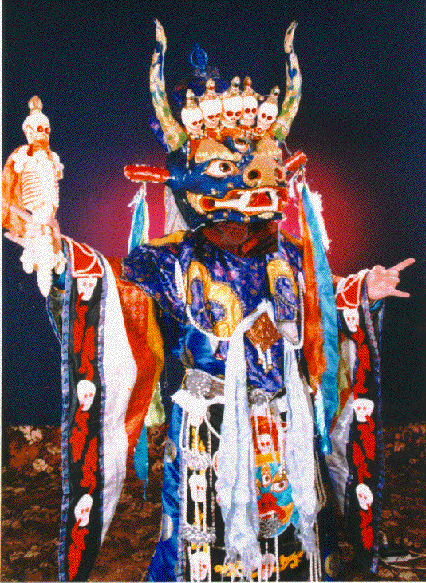 |
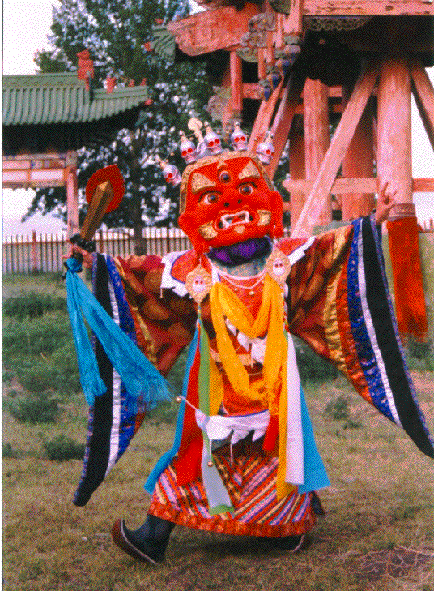 |
 |
|
Tshoijoo
|
Jamsran
|
Old White Man
|
- Contortionist (acrobatics)
The performances of court favorites, who twisted and turned their bodies in such a way as to produce strange and difficult patterns. This art has not waned through the years. Acrobatics and allied fields have flourished to a point where there is no position or posture which cannot be assumed by some artist of contortion.
Latest compact discs:
- "Ayalguu - Vol. I": FM 50043 - "Magtaal / Höömij - Vol. II": FM 50044
- "Chinggis Ayalguu - Vol. III" -- FM 50051 - "Ardiin Ayalguu - Vol. IV" - FM 50052
|
|
